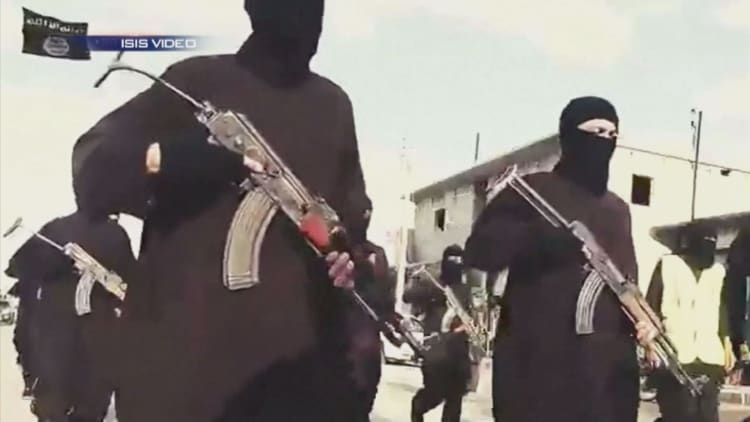Even before President Obama announced a U.S. military expansion in Syria on Monday, the Pentagon's stepped-up campaign against the Islamic State in Iraq and Syria (ISIS) had led analysts and others to conclude that billions of dollars in additional funds were needed to replenish munitions depleted by strikes on the terrorists.
"We've kind of run through what we've had," said Howard Rubel, an analyst at Jefferies & Co. "You've got to keep the troops prepared."
The defense businesses at Raytheon, Lockheed Martin, Boeing and other key suppliers of weapons could benefit in coming quarters as the military replaces missiles, bombs, rockets and other explosives it has expended against ISIS. Many of the leading defense companies reporting first-quarter earnings this week are expected to provide an update on order trends.
As of April 12, Pentagon figures show the nearly two-years-old campaign against ISIS has involved 8,825 U.S. strikes in Iraq and Syria, and another 2,714 by allies. The total cost now exceeds $7 billion, or $11.6 million a day. Approximately 70 percent of the daily spending goes to the Air Force.
Sterne Agee CRT analyst Peter Arment said he expects the "munitions burn rate" to "remain high coupled with the depletion of missile inventories. The Air Force has been rapidly depleting its war time inventory levels with over 22,700-plus missiles and bomb-related munitions used since August 2014."
The Pentagon's $582.7 billion budget request for fiscal 2017 includes about $7.5 billion in spending for Operation Inherent Resolve against ISIS terrorists in Iraq and Syria. The overall 2017 budget includes $13.9 billion for missiles and munitions, up about 17 percent from the prior year.

According to the Department of Defense budget request, the military is prioritizing everything from Boeing's Joint Direct Attack Munition (JDAM) bombs and Lockheed's Hellfire missiles to Raytheon's Tomahawk missiles. Defense wants to essentially double the production of the JDAM program to 36,500 units per year by the fourth quarter of fiscal 2017 and to increase Hellfire production by more than 20 percent by fiscal year 2018. Small Diameter Bomb production, a precision-guided air-to-ground weapon system from Boeing and Raytheon, also would be increased in the proposed budget.
Arment said whether it's Raytheon's Tomahawk or Boeing's JDAM, missiles are in "big demand" — and it's not just from the U.S. military but international customers as well.
Boeing's JDAM production increased by nearly 80 percent last July to meet domestic and international demand, and the company has indicated that it has capacity to further increase quantities once contracts are in place. The JDAM production team includes parts and system suppliers such as Honeywell, Rockwell Collins, Textron and Lockheed Martin, among others.
"Boeing stands ready to adjust production quantities for any of our weapons and missile systems programs at any time at the request of our customers to meet their mission quickly and affordably," Boeing said in a statement to CNBC.
Boeing is set to report first-quarter earnings before the market opens Wednesday. The Street expects a decline in Boeing's earnings and revenue compared with the same period last year. Boeing's defense unit is seen having improved top-line growth in the quarter, although the company is expected to take a hit on the commercial aircraft side.
on Tuesday morning, sending its shares up as much as about 2 percent as the company issued improved guidance for the year. Revenue rose about 16 percent, with the Aeronautics segment showing the strongest growth; the company's Missiles and Fire Control division was up nearly 4 percent.
Last week, Lockheed received a contract valued at nearly $117 million involving its Joint Air-to-Surface Standoff Missiles (JASSM) from the Air Force. Lockheed's Missiles and Fire Control segment represented 14 percent of the company's total revenue last year.
Northrop Grumman, another major weapons maker, is set to report Wednesday before the market opens. Revenue is expected to be flat and earnings up about 3 percent from the same time last year, according to analysts surveyed by Thomson Reuters.
Raytheon is expected to report results on Thursday, and some analysts expect the company to reveal more details on Middle East defense spending, including interest from Gulf States. Earnings are forecast to decline 23 percent, although revenue is expected to increase about 3 percent. Raytheon declined comment for this story.
Meantime, the Subcommittee on Tactical Air and Land Forces of the House Armed Services Committee last week mentioned the munition situation in its "markup" document on the 2017 defense authorization bill. It referred to "munitions gaps and shortfalls," and two key members of the panel — Subcommittee Chair Mike Turner (R-Ohio) and Ranking Member Loretta Sanchez (D-Calif.) — called for more funding.
"We're using stuff up at a rate that's requiring us to spend, and the budget may not fully reflect that need," said Rubel, the Jefferies analyst.
Additionally, the House Subcommittee hinted at the possibility of restarting production of the F-22 fighter. Production of the Lockheed stealth aircraft ceased in 2009, well short of the program's objective of nearly 750 aircraft.






